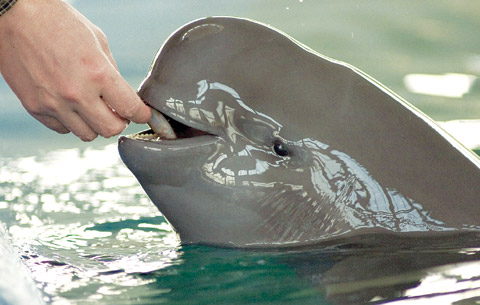Chinese 'river pigs' rarer than giant pandas
 0 Comment(s)
0 Comment(s) Print
Print E-mail Xinhua, March 28, 2013
E-mail Xinhua, March 28, 2013
A report released on Thursday said the population of China's finless porpoise is decreasing at a faster pace, suggesting looming extinction for the rare freshwater mammal.
Based on a survey conducted last year, the report by the Ministry of Agriculture estimates that there are only about 1,000 finless porpoises, or "river pigs" in Chinese, in their only habitats in the Yangtze River and two nearby lakes.
The report said the porpoises' population has decreased by 13.73 percent every year, twice the rate reported before 2006. Experts have warned the species could die out within a decade if the trend is not reversed.
Finless porpoises are found only in the Yangtze River, China's longest river, as well as Dongting and Poyang, two lakes that link to the waterway. A symbol of the river, the porpoises are known for their "smiling" faces and friendly relations with humans.
Their predicament has attracted greater attention since a 2006 survey found that their population had decreased to 1,800 due to human activity and pollution. The survey also declared the white-flag dolphin, a larger mammal native to the river, to be functionally extinct.
Chinese scientists launched a new round of surveying last October, sailing between the cities of Yichang and Shanghai along a 1,700-kilometer section of the Yangtze River to track the mammal using a sonar system and visual observation.
The report estimates there are about 540 finless porpoises in Poyang and Dongting and 500 others in the Yangtze River. Of the latter, 67 percent are believed to be living in waters between Hukou County in Jiangxi Province and the city of Nanjing in Jiangsu Province.
The report said the porpoises' habitats are isolated and concentrated in certain spots, a harmful trend for the species' reproduction, which depends on seasonal migration.
"Busy ship traffic has disrupted their migration and changing hydrologic conditions due to the construction of water projects also shrank their habitats," said Wang Ding, head of the survey team.
Wang, also a researcher from the Institute of Hydrobiology under the Chinese Academy of Sciences (CAS), identified intense water traffic on the Yangtze, now China's busiest waterway, and a lack of food as major threats to the porpoises' existence.
The porpoises rely on sonar for movement and are often confused by the noise of boat propellers, leading to fatal collisions with boats. Researchers said illegal fishing and worsening pollution in the river have resulted in a lack of food for the mammal.
The latest survey was organized by the Ministry of Agriculture, the CAS and the World Wide Fund for Nature (WWF).
Environmentalists hope the report can prompt more government efforts to protect the endangered mammal, including moving it onto China's top list of protected wildlife.
The report calls for a fishing ban in Poyang, which boasts a large number of such porpoises, as well as relocating local fishermen to other industries and enlarging conservancy sites.
Authorities said previously that they had planned the construction of more conservancy sites for finless porpoises. A new artificial reproduction center will be built in three to five years.







Go to Forum >>0 Comment(s)